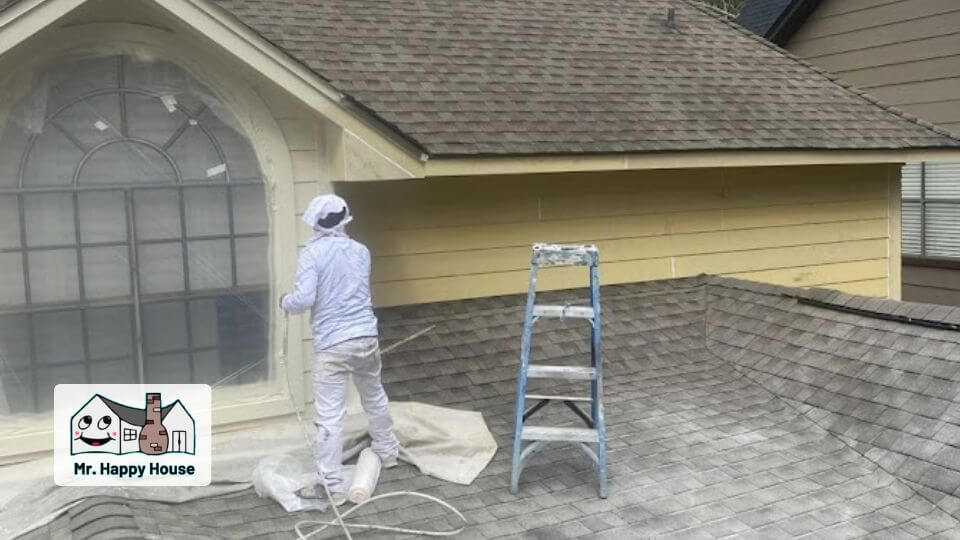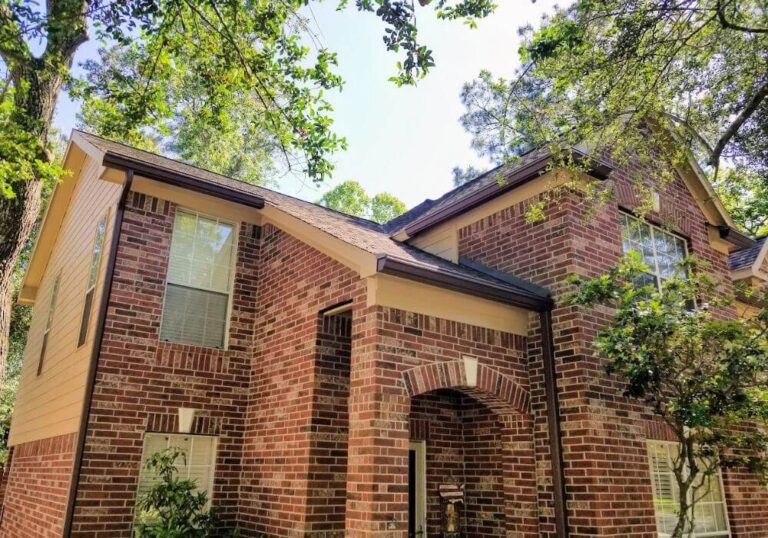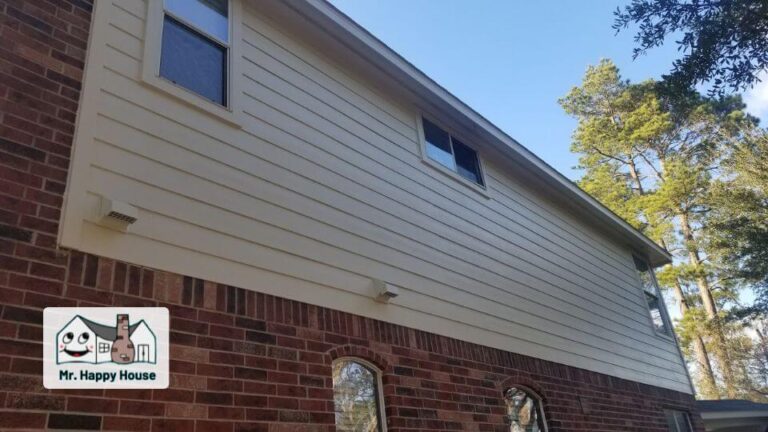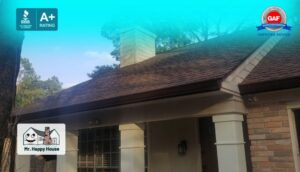
Best GAF Certified Roofers in The Woodlands, TX – Quality Roof Replacement, Gutters & Siding
Best GAF Certified Roofers in The Woodlands, TX – Quality Roof Replacement, Gutters & Siding Best GAF Certified Roofers in The Woodlands, TX – Quality

When faced with deteriorating or damaged siding, Homeowners in The Woodlands often grapple with the decision of whether to repair or replace siding entirely. This choice can be influenced by various factors, including the extent of the damage, budget constraints, aesthetic preferences, and long-term sustainability goals.
Is it better to repair or replace siding on your Woodlands Home? Firstly, understanding the implications of each option is crucial in making an informed decision that not only addresses immediate concerns but also aligns with the overall maintenance and improvement goals for your home. In this article, we dive into the specifics of choosing between siding repair and replacement, aiming to provide you as the homeowner with clarity and guidance in preserving the integrity and value of your home.

Before making the decision to repair or replace your siding on your home in The Woodlands, it’s imperative to conduct a comprehensive assessment of the current state of your siding. Start by visually inspecting the exterior of your home, looking for any visible signs of damage or deterioration. This includes checking for cracks, chips, warping, rotting, or areas where the siding may be pulling away from the wall. Additionally, examine the condition of the paint or finish, as peeling or flaking can indicate underlying issues such as rotted wood.
Take note of any areas where moisture might be seeping in, as this can lead to further damage and potentially compromise the structural integrity of your home. It’s also important to consider the age and material of your siding. Different materials, such as vinyl (which isn’t recommended for homes in The Woodlands or Houston area), wood, fiber cement, or metal, have varying lifespans and maintenance requirements.
For instance, vinyl siding (which you shouldn’t install on your Woodlands home for many reasons) can become brittle over time, especially in extreme weather conditions. On the other hand, wood siding is susceptible to rot and insect damage if not properly maintained.
Take into account any previous repairs or maintenance efforts, as they can impact the overall condition and longevity of your siding. By thoroughly understanding the current state of your siding, including any underlying issues or vulnerabilities, you can make a more informed decision about whether repair or replacement is the most suitable option for your home.
Before deciding whether to repair or replace your siding, there are several important factors to take into consideration. Firstly, assess the extent of the damage to your siding. Minor issues such as small cracks or chips may be easily repairable, while extensive damage or structural issues may necessitate replacement. Next, consider your budget constraints. Repairing siding is often a more cost-effective solution in the short term, but if your siding is nearing the end of its lifespan or requires frequent repairs, investing in a full siding replacement may be a more economical long-term option.
Additionally, think about the aesthetic impact of your decision. New siding can dramatically improve the appearance of your home and increase its curb appeal, whereas repairing damaged siding may not achieve the same level of visual enhancement. Here at Mr. Happy House, we are a professional siding company installing the best of class and in durability siding – James Hardie Siding.
Evaluate your long-term maintenance goals and how they align with the durability and longevity of your chosen siding option.
Repairing siding presents several advantages worth considering. Firstly, it can be a good choice if you’re tight on finances at the moment, particularly for addressing minor damages or localized issues. By opting for repairs instead of a full replacement, you as the homeowner can often save on costs associated with materials and labor. Moreover, repairing specific sections of siding allows for targeted fixes, preserving the overall aesthetic appeal of the home without necessitating a comprehensive overhaul.
Another benefit of siding repairs is the potential for reduced time and disruption compared to a full replacement. Repair work typically requires less time and labor, minimizing inconvenience to homeowners and allowing them to resume their daily routines more swiftly. Additionally, from an environmental standpoint, repairing siding can be a more sustainable option as it generates less waste by utilizing existing materials rather than replacing them entirely.
However, there are notable drawbacks to consider as well. While repairs may offer a temporary solution, they might not address underlying issues that could lead to further damage down the line. Failure to adequately resolve these underlying issues can result in the need for more extensive repairs or even premature replacement in the future.
Furthermore, achieving a seamless match between new repairs and existing siding can be challenging, potentially resulting in a mismatched appearance that detracts from the home’s overall aesthetic.
Depending on the extent of the damage and the age of the siding, the cumulative costs of repeated repairs may outweigh the initial savings, making replacement a more cost-effective option in the long term. Therefore, homeowners should carefully weigh the pros and cons of repairing siding before making a decision, considering factors such as the extent of the damage, budget constraints, and long-term maintenance goals.

Replacing siding offers several potential advantages. Firstly, it provides an opportunity to address underlying issues comprehensively, ensuring that any structural damage or deterioration is effectively resolved. By replacing old or damaged siding with new materials, homeowners can enhance the overall durability and longevity of their home’s exterior, potentially reducing the need for frequent repairs in the future. Additionally, replacing siding allows for greater flexibility in design and customization, enabling homeowners to choose materials, colors, and styles that best suit their aesthetic preferences and architectural style.
Another advantage of siding replacement is the potential for improved energy efficiency. Especially with professionally installed Hardie Siding, this can help better regulate indoor temperatures and reduce energy consumption for heating and cooling. This can result in lower utility bills and increased comfort for occupants, making siding replacement a worthwhile investment in the long run. Moreover, by upgrading to energy-efficient siding options, homeowners may also qualify for various incentives, rebates, or tax credits aimed at promoting sustainability and environmental conservation.
However, one of the drawbacks of a full siding replacement is the cost, which can be substantially higher than repairing existing siding. The expenses include not only the materials themselves but also labor costs for installation, disposal of old materials, and any additional preparatory work required.
In summary, while siding replacement offers numerous benefits in terms of durability, energy efficiency, and aesthetic enhancement, it’s essential for homeowners to weigh these advantages against the associated costs and potential disruptions. By carefully considering factors such as the condition of the existing siding, budget constraints, and long-term maintenance goals, homeowners can make an informed decision that best meets their needs and priorities.
In the debate between repairing and replacing siding, there is no one-size-fits-all solution. Both options offer their own set of advantages and drawbacks, and the decision ultimately depends on various factors such as the extent of damage, budget considerations, aesthetic preferences, and long-term maintenance goals.
Homeowners must carefully assess the condition of their siding and weigh the pros and cons of each option before making a decision. While repairing siding may offer a cost-effective and less disruptive solution in the short term, it may not address underlying issues or provide long-lasting benefits.
On the other hand, replacing siding provides an opportunity for comprehensive improvement, including enhanced durability, energy efficiency, and aesthetic appeal, but it comes with higher upfront costs and potential disruptions. By considering these factors thoughtfully and consulting with professionals if needed, homeowners can make an informed choice that best suits their needs and ensures the integrity and value of their home’s exterior for years to come.
We hoped you loved this article on if it's better to repair or replace siding on your home, please share and tune in for more roofing, siding, and house painting content!
Our Services:













Best GAF Certified Roofers in The Woodlands, TX – Quality Roof Replacement, Gutters & Siding
Best GAF Certified Roofers in The Woodlands, TX – Quality Roof Replacement, Gutters & Siding Best GAF Certified Roofers in The Woodlands, TX – Quality

Are Gutters Part of the Roofing System?
Are Gutters Part of the Roofing System? Are Gutters Part of the Roofing System? When it comes to home maintenance, gutters often seem like a

Why James Hardie is The Best Option for Home Siding
Why James Hardie is The Best Option for Home Siding Why James Hardie is The Best Option for Home Siding James Hardie stands out whether











